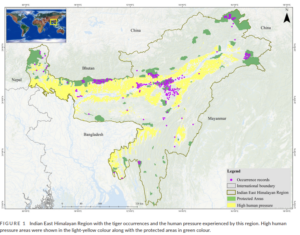Abstract:

Large mammals are susceptible to land use and climate change, unless they are safeguarded within large, protected areas. It is crucial to comprehend the effects of these changes on mammals to develop a conservation plan. We identified ecological hotspots that can sustain an ecosystem for the endangered Bengal tiger (Panthera tigris tigris), an umbrella species. We developed three distinct ensemble species distribution models (SDMs) for the Bengal tiger in the Indian East Himalayan Region (IEHR). The first model served as the baseline and considered habitat type, climate, land cover, and anthropogenic threats. The second model focused on climate, land use, and anthropogenic threats, the third model focused on climate variables. We projected the second and third models onto two future climate scenarios: RCP 4.5 and RCP 8.5. We evaluated the threats possess to protected areas within eco-sensitive zone based on the potential tiger habitat. Finally, we compared the potential habitat with the IUCN tiger range. Our study revealed that the Brahmaputra valley will serve as the primary habitat for tigers in the future. However, considering the projected severe climate scenarios, it is anticipated that tigers will undergo a range shift towards the north and east, especially in high-altitude regions. Very high conservation priority areas, which make up 3.4% of the total area, are predominantly located in the riverine corridor of Assam. High conservation priority areas, which make up 5.5% of total area are located in Assam and Arunachal Pradesh. It is important to note that conservation priority areas outside of protected areas pose a greater threat to tigers. We recommend reassessing the IUCN Red List’s assigned range map for tigers in the IEHR, as it is over-predicted. Our study has led us to conclude both land use and climate change possess threats to the future habitat of tigers. The outcomes of our study will provide crucial information on identifying habitat hotspots and facilitate appropriate conservation planning efforts.

